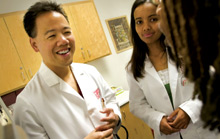 LOS ANGELES – The School of Pharmacy at the University of Southern California announced today that it will double its presence in clinics and medical homes that deliver health care services to the uninsured, the poor and the homeless. The School began providing clinical pharmacy services in safety-net clinics in 2002, and currently is a key partner with 12 such clinics in Southern California. The new USC Medication Therapy and Safety Initiative aims to increase the School’s coverage to 24 clinics and medical homes by 2013.
LOS ANGELES – The School of Pharmacy at the University of Southern California announced today that it will double its presence in clinics and medical homes that deliver health care services to the uninsured, the poor and the homeless. The School began providing clinical pharmacy services in safety-net clinics in 2002, and currently is a key partner with 12 such clinics in Southern California. The new USC Medication Therapy and Safety Initiative aims to increase the School’s coverage to 24 clinics and medical homes by 2013.
This increased commitment to community is desperately needed, with the continuing economic crisis making these clinics even more vital to meeting the health needs of underprivileged communities, as demand increases and public funding decreases. New census statistics show that more than 15 percent of Americans live below the national poverty level. In California the numbers are even worse, with more that 16 percent in poverty and nearly 20 percent lacking health insurance. Los Angeles County alone is home to more than 2.7 million uninsured.
A USC clinical study demonstrates that integrating pharmacy services into safety-net clinics and medical homes results in measurable improvements in care. For example, hypertension patients had reduced blood pressure, and patients with diabetes showed improvements in blood-glucose control.
“The USC School of Pharmacy’s work in safety-net clinics enables us to have a direct and positive impact on the city’s most at-risk residents,” says Dean R. Pete Vanderveen. “And, since these economic problems face the entire country, we are urging our fellow pharmacy schools to increase their outreach efforts as well.”
“The American Association of Colleges of Pharmacy [AACP] is delighted that USC is doubling its capacity to collaborate with community partners to improve the health of the citizens of Los Angeles,” says William Lang, AACP vice president of policy and advocacy. “This new initiative reflects our organizational commitment of increasing our members’ community engagement in ways that create real value to patients, prescribers and faculty and students. USC sends a strong message to its fellow academic institutions that health and education go hand in hand toward creating sustainable, livable communities.”
Appropriately, the launch of this new initiative coincides with American Pharmacists Month, which recognizes the profession’s crucial role in improving patient care. Pharmacists help patients maximize the benefits of their medications by managing drug therapy and by identifying, preventing and resolving medication-related problems.
Pharmaceutical care services include educating and monitoring patients with chronic diseases—such as diabetes, hypertension, asthma, high cholesterol and heart failure—who often take multiple medications for their conditions. Once diagnosed by a physician, patients are referred to a staff pharmacist for medication therapy management and ongoing monitoring of their drug regimen.
“Staff pharmacists, working under protocols, adjust prescribed therapies and provide patient education to help ensure that each patient reaches treatment goals safely and effectively,” observes Steven Chen, associate professor of clinical pharmacy and one of the School’s leading faculty serving in safety-net clinics.
The improved patient outcomes and cost savings that occur when pharmacists are part of patient-centric, health care teams have been shown in clinical settings ranging from hospitals to the Department of Veterans Affairs. A healthier population, in turn, should help drive down the health care costs that have risen so alarmingly—by keeping patients healthier and out of the emergency room and hospital. Further, having a pharmacist manage medication therapy for the most complicated patients increases access to health care, as it frees up the physician to see more patients.
Pharmacy students and residents benefit from the program as well, since the clinics provide ideal training for a diverse population and a wide range of diseases and conditions. For the faculty members who provide services, the clinics also offer opportunities for research and to collect crucial data regarding health outcomes, medication safety, health literacy and cultural competency that ultimately will lead to further advances in care.
Increasing the number of clinics and medical homes where students and residents are trained also is important because the more exposure they gain to such facilities, the more likely they’ll choose to dedicate their careers to helping people in these settings, according to Dean Vanderveen. “This trains even more pharmacists to work on the frontline to meet the nation’s most pressing health care needs,” he notes.
“USC is one of the most active schools in the nation in developing leading integrated care models for the underserved,” adds Chen, who also serves as co-chair emeritus of the Health Resources and Services Administration (HRSA) Patient Safety and Clinical Pharmacy Collaborative —part of the U.S. Department of Health and Human Services—which aims to increase the number of schools working with clinics nationwide. The USC safety-net initiative was launched with an HRSA seed grant in 2002.
“We will continue working with the HRSA Patient Safety and Clinical Pharmacy Services Collaborative as we increase our support of the underserved in Southern California,” says Dean Vanderveen. “This new initiative also is a great opportunity for the USC School of Pharmacy to positively impact our community and to share an effective model that can be adopted throughout the country.”

